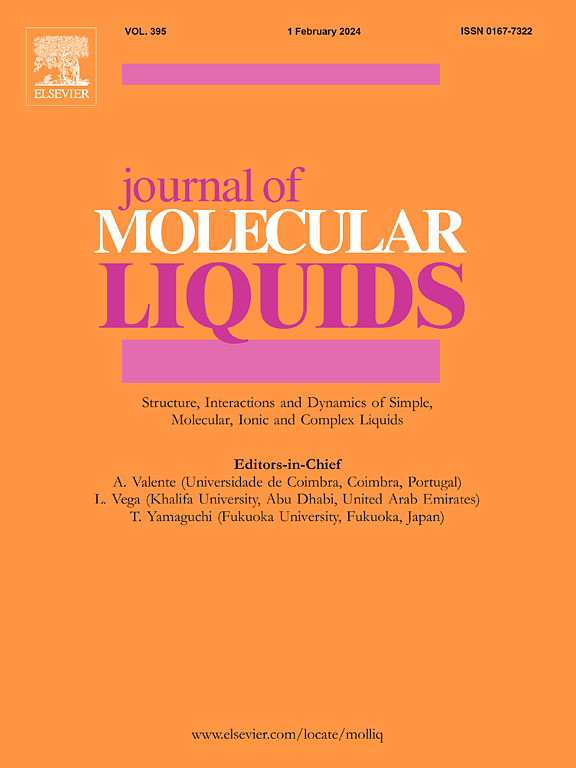Enhanced nickel (II) removal from aqueous media using magnesium-Punica granatum linn based adsorbent: Mechanism and performance
IF 5.3
2区 化学
Q2 CHEMISTRY, PHYSICAL
引用次数: 0
Abstract
The rapid expansion of urbanization and industrial activities has led to a substantial increase in the discharge of heavy metals into aquatic environments. This study employs the distinctive properties of MgO-BCK to synthesize magnesium oxide embedded in biochar (Punica granatum linn)-modified KOH through a one-step precipitation method. The results offer significant insights into optimizing adsorbent design and operational conditions for efficient Ni(II) removal at low concentrations via batch adsorption from aqueous solutions. The biochar surface became rough and uniformly layered with MgO, increasing the specific surface area to 46.448 m2/g. Before modification, the specific surface area of the biochar was 30.685 m2/g, providing numerous adsorption sites for Ni(II) removal. The removal efficiency greater than 97.67 % was achieved for nickel ions from an aqueous solution with an initial concentration of 20 mg/L, using 22 mg of the adsorbent at 318 K under neutral pH conditions. The adsorption data fitted well to the pseudo-second-order kinetic and Langmuir isotherm models, indicating that the process involves homogeneous chemisorption. Co-existing anions ( ) and cations (Cd (II) and Mn (II)) had minimal impact, but 100 mg/L of NO3−, HCO3−, PO43−, Fe (III), Cr(VI) mixed anions/cations reduced adsorption capacities. Additionally, the nickel removal efficiency of MgO-BCK was maintained at 81.80 % (40.80 mg/g) even after seven regeneration cycles. Electrostatic interaction, ion exchange, and physical and chemical adsorption were suggested as potential adsorption processes based on the findings of Ni(II) uptake tests, EDS, FTIR, and XPS investigations. This study suggests that MgO-BCK is a promising material for removing Ni (II) from wastewater.
镁-石榴木基吸附剂对水中镍(II)的强化去除:机理与性能
城市化和工业活动的迅速扩大导致向水生环境排放重金属的大量增加。本研究利用氧化镁- bck的独特性质,采用一步沉淀法将氧化镁包埋在生物炭(Punica granatum linn)改性KOH中。结果为优化吸附剂的设计和操作条件提供了重要的见解,从而通过间歇吸附从水溶液中高效去除低浓度的Ni(II)。添加MgO后,生物炭表面变得粗糙均匀,比表面积达到46.448 m2/g。改性前,生物炭的比表面积为30.685 m2/g,为去除Ni(II)提供了大量的吸附位点。在初始浓度为20 mg/L的水溶液中,在318 K、中性pH条件下,吸附剂用量为22 mg,对镍离子的去除率大于97.67%。吸附数据符合拟二级动力学模型和Langmuir等温线模型,表明吸附过程为均匀化学吸附。阴离子(Cl-、SO42-)和阳离子(Cd (II)、Mn (II))共存对吸附性能影响较小,但100 mg/L NO3−、HCO3−、PO43−、Fe (III)、Cr(VI)混合阴离子/阳离子对吸附性能影响较小。经过7次再生后,MgO-BCK的除镍效率仍保持在81.80% (40.80 mg/g)。基于Ni(II)吸收试验、EDS、FTIR和XPS的研究结果,认为静电相互作用、离子交换和物理化学吸附是潜在的吸附过程。该研究表明,MgO-BCK是一种很有前途的去除废水中Ni (II)的材料。
本文章由计算机程序翻译,如有差异,请以英文原文为准。
求助全文
约1分钟内获得全文
求助全文
来源期刊

Journal of Molecular Liquids
化学-物理:原子、分子和化学物理
CiteScore
10.30
自引率
16.70%
发文量
2597
审稿时长
78 days
期刊介绍:
The journal includes papers in the following areas:
– Simple organic liquids and mixtures
– Ionic liquids
– Surfactant solutions (including micelles and vesicles) and liquid interfaces
– Colloidal solutions and nanoparticles
– Thermotropic and lyotropic liquid crystals
– Ferrofluids
– Water, aqueous solutions and other hydrogen-bonded liquids
– Lubricants, polymer solutions and melts
– Molten metals and salts
– Phase transitions and critical phenomena in liquids and confined fluids
– Self assembly in complex liquids.– Biomolecules in solution
The emphasis is on the molecular (or microscopic) understanding of particular liquids or liquid systems, especially concerning structure, dynamics and intermolecular forces. The experimental techniques used may include:
– Conventional spectroscopy (mid-IR and far-IR, Raman, NMR, etc.)
– Non-linear optics and time resolved spectroscopy (psec, fsec, asec, ISRS, etc.)
– Light scattering (Rayleigh, Brillouin, PCS, etc.)
– Dielectric relaxation
– X-ray and neutron scattering and diffraction.
Experimental studies, computer simulations (MD or MC) and analytical theory will be considered for publication; papers just reporting experimental results that do not contribute to the understanding of the fundamentals of molecular and ionic liquids will not be accepted. Only papers of a non-routine nature and advancing the field will be considered for publication.
 求助内容:
求助内容: 应助结果提醒方式:
应助结果提醒方式:


